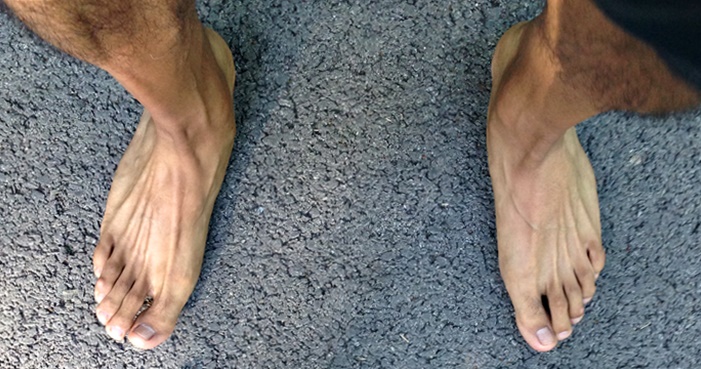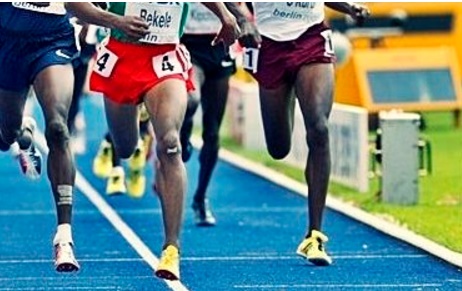Have you ever suffered a metatarsal stress fracture from running? It’s a common running injury, but why? Humans evolved to run –on our feet– barefoot. Barefoot running without injury, was astonishingly achieved by our ancestors. We therefore, evolved to have strong feet, particularly strong foot bones, such as the metatarsals.
The problem today is that conventional wisdom suggests cushioned running shoes are vital for protection, but many runners are abandoning their running shoes in favor of barefoot running or minimalist running simply because they run pain-free when they run shoeless.

Metatarsal Stress Fracture From Running
A metatarsal stress fracture is not something you want. It’s very painful and requires months to fully heal. In fact, studies have shown that cushioned running shoes increase the repetitive exposure of impact pressure and loading within the foot in such a way that results in bone fatigue, causing fracture.
Ever wonder why these impact variables arise during running? Believe it or not, cushioned running shoes increase these types of impacts during running because they cause the foot to strike the ground faster and harder, which ends up fatiguing the bone if you run long distances, or if you run at fast running speeds.
- Running shoes with cushioning may increase your risk of a fatigue fracture because they lead to abnormal pressure distribution patterns on the lower leg. They also increase plantar pressure in the forefoot and may increase the risk of a metatarsal stress fracture.
Most conventional running shoes have an elevated heel, yet the purpose of the raised heel is under speculation as injury rates among runners remains unacceptably high.
Previous studies showed that raised heel running shoes altered biomechanics during running, which included:
- changes in loading pattern of the lower leg
- increased foot plantar pressures
- changes in foot strike pattern from a forefoot strike to a heel strike
- uneven plantar pressure distribution from the outer part of the foot (4th and 5th metatarsal) to the inner part (1st and 2nd metatarsals)
In short, the biomechanical impairments associated with heeled running shoes contribute to soft tissue damage of the foot resulting in foot pain and injuries such as metatarsal stress fractures.
Sadly, the picture becomes more disappointing. Since heeled running shoes facilitate a heel strike landing pattern, an impact transient force is produced -a force not produced in a forefoot strike landing.
- studies showed the vertical ground reaction force associated with heel striking occurred at a magnitude of 3 times the body’s weight per step
- the vertical ground reaction force is strongly linked to repetitive stress injuries in runners, particularly tibial fatigue fractures
- thick heeled running shoes, commonly worn by heel strikers, increases the risk of metatarsal stress fractures as plantar pressures abnormally distributed on the 1st and 2nd metatarsal heads during foot rollover
Evidently, research suggests that the 1st and 2nd metatarsal heads do not have the capacity to effectively dissipate impact related to heel strike running.
Likewise, it is excepted by many experts that a runner should make initial contact with the ground on the forefoot (balls of the foot, shown below) underneath the 3rd, 4th, and 5th metatarsal heads as this portion of the foot has been shown to be better able to absorb and distribute plantar pressures.

- Show above, elite distance runners who are forefoot strikers. Initial contact is made on the outer-side of the forefoot, under the 5th to 3rd metatarsal heads before the rest of the foot comes in contact with the ground. Landing this way has been implicated in adequately distributing plantar pressures in the forefoot and may prevent impact from traveling up the shin by keeping forces ‘contained’ within the forefoot.
More From Run Forefoot:
How to prevent cold toes in the VFFs during the winter
Why increasing your foot’s proprioception can be an advantage
Running faster causes you to run with less impact
How heel strike and forefoot strike running differ mechanically
30 most preferred minimalist shoes for forefoot running
References:
Esenyel et al. Kinetics of high-heeled gait. J Am Podiatr Med Assoc, 2003; 93(1):37-32.
Galloway, HR. Overuse injuries of the lower extremeity. Radiol Clin North Am, 2013.51(3): 511-28.
Gou et al. Effect on plantar pressure distribution with wearing different base size of high-heel shoes during walking and slow running. J Mech Med Biol, 2012; 12(1).
Milner et al. Biomechanical factor associated with tibial stress fractures in female runners. Med Sci Sports Exerc, 2006; 38(2): 323-8
Wen, DY., Puffer, JC and Schmalzried, TP. Med Sci Sports Exerc, 1997; 29(10):1291-8.
Wiegerinck et al. Difference in plantar loading between training shoes and racing flats at a self-selected running speed. Gait Posture, 2009; 29(3): 514-9.
Bretta Riches
BSc Neurobiology; MSc Biomechanics candidate, ultra minimalist runner & founder of RunForefoot. I was a heel striker, always injured. I was inspired by the great Tirunesh Dibaba to try forefoot running. Now, I'm injury free. This is why I launched Run Forefoot, to advocate the health & performance benefits of forefoot running and to raise awareness on the dangers of heel striking, because the world needs to know.
Latest posts by Bretta Riches (see all)
- Are Minimalist Shoes Good for Seniors? YES! - 14/04/2024
- BIG Deals On Running Gear And More! - 09/04/2024
- Why Are My Feet Tired After Running? - 04/04/2024

Leave a Reply